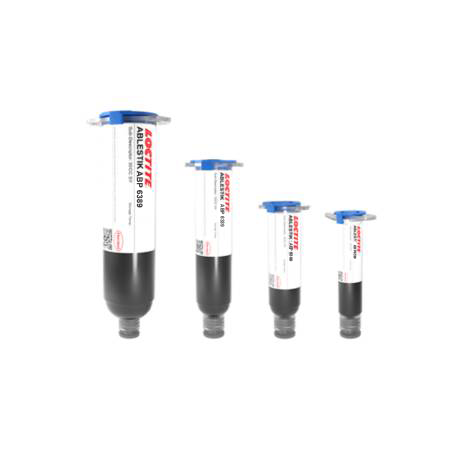LOCTITE ABLESTIK ABP 6389
Harmonization Code : 3506.91.90.99 | Prepared glues and other prepared adhesives, not elsewhere specified or included; products suitable for use as glues or adhesives, put up for retail sale as glues or adhesives, not exceeding a net weight of 1 kg ; Adhesives based on polymers of headings 3901 to 3913 or on rubber; Other ; Other
Main features
- High-reliability QFP manufacture
- Low outgassing
- Good adhesion to BSM & Non BSM die
Product Description
LOCTITE®ABLESTIK ABP 6389 electrically conductive die attach adhesive is designed for high reliability package applications. It is formulated with good thermal conductivity for heat management, along with excellent electrical conductivity to achieve low ON Resistance (RDS(ON)) in MOSFET devices.
LOCTITE®ABLESTIK ABP 6389 is engineered to bond with or without BSM (BacksideMetallization) die. Its moderate modulus, good adhesion and low stress enable robust bonding of small to large die on a wide variety of metal surfaces, including bare Copper, Ag and PPF leadframes. This low outgassing epoxy is typically used for SOIC, SOP, QFP and QFN package applications
Cure Schedule
- 30 minutes ramp to 175°C+60 minutes @175°C, in N2 or air
Technical Specifications
| Thermal Properties | |
| Glass Transition Temperature (Tg) Glass Transition Temperature (Tg) The glass transition temperature for organic adhesives is a temperature region where the polymers change from glassy and brittle to soft and rubbery. Increasing the temperature further continues the softening process as the viscosity drops too. Temperatures between the glass transition temperature and below the decomposition point of the adhesive are the best region for bonding. The glass-transition temperature Tg of a material characterizes the range of temperatures over which this glass transition occurs. | 34 °C |
| Thermal Conductivity Thermal Conductivity Thermal conductivity describes the ability of a material to conduct heat. It is required by power packages in order to dissipate heat and maintain stable electrical performance. Thermal conductivity units are [W/(m K)] in the SI system and [Btu/(hr ft °F)] in the Imperial system. | 8 W/m.K |
| Weight Loss @ 300°C | 2.8 % |
| Physical Properties | |
| Thixotropic index Thixotropic index Thixotropic Index is a ratio of a material s viscosity at two different speeds in Ambient temperature, generally different by a factor of ten. A thixotropic material s viscosity will decrease as agitation or pressure is increased. It indicates the capability of a material to hold its shape. Mayonnaise is a great example of this. It holds its shape very well, but when a shear stress is applied, the material easily spreads. It helps in choosing a material in accordance to the application, dispense method and viscosity of a material. | 4.4 |
| Viscosity Viscosity Viscosity is a measurement of a fluid’s resistance to flow. Viscosity is commonly measured in centiPoise (cP). One cP is defined as the viscosity of water and all other viscosities are derived from this base. MPa is another common unit with a 1:1 conversion to cP. A product like honey would have a much higher viscosity -around 10,000 cPs- compared to water. As a result, honey would flow much slower out of a tipped glass than water would. The viscosity of a material can be decreased with an increase in temperature in order to better suit an application | 8,000 mPa.s |



